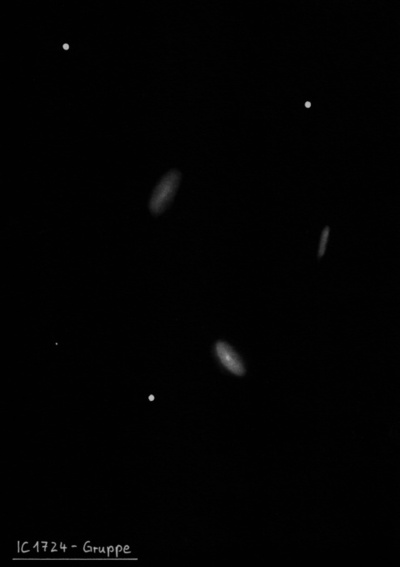A faint constellation of the southern sky below the Whale and Aquarius, east of the Southern Fish. In this tiny constellation east of Fomalhaut lies the South Galactic Pole, which marks one of the two points on the axis of rotation of our Galaxy. The latter is shaped like a disk that rotates around its core, and the axis of rotation is perpendicular to the plane of the Milky Way. The points where the axis crosses the sky are called the galactic poles. The northern galactic coordinates lie in the constellation Berenice's Hair. Because we are looking into this region as if out of our Galaxy, we can see only a small number of stars in that direction; gas and dust clouds are scattered. This is also the direction we have the best view of distant space and can observe a number of extragalactic objects. In the constellation is the so-called Sculptor system, a dwarf member of our Local Group of galaxies, only 260,000 light-years away, but with too low an areal brightness to be detected in amateur telescopes. Much more favourable is the observation of members of the galaxy cluster in Sculptor, a handful of spiral galaxies just 8 million light-years away, making it probably the closest galaxy cluster to the Local Group. Sometimes referred to as the "South Galactic Pole Group", two of these galaxies, NGC 55 and NGC 253, mainly from the equatorial regions where they stand out higher on the meridian, can be detected in ordinary binocular.
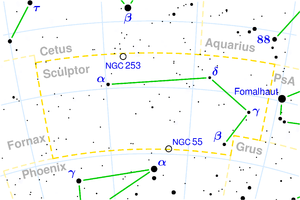
α Scl - The brightness of a constellation is often indicated by its brightest star, which has a magnitude of only 4.39. Its probable distance is 780 light-years. Just north of it lies the southern galactic pole.
ε Scl - A physical binary star with an orbital period of 1,200 years, whose components have magnitudes of 5.4 and 8.6 and are separated by 4.7". They can be resolved with a 100 mm telescope. Both stars have a yellow color and are located 92 light-years away.
κ1 Scl - A binary star with bright components of 6.1 magnitude and 6.2 magnitude, which are, however, located very close to each other - 1.4". Both have a yellow color.
τ Scl - A close pair (2.2") of bright yellow stars with magnitudes 6 and 7.1.
R Scl - Variable red giant, whose brightness varies in an approximately one-year cycle ranging from 6 to 8 mag.
NGC 253
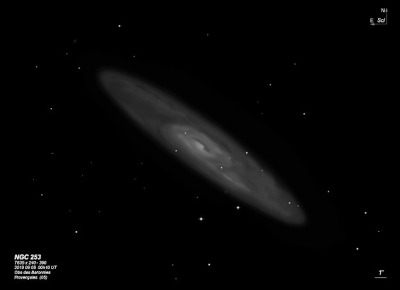
10x30mm IS binoculars: easily visible as an elongated glow.
Caroline Herschel discovered NGC 253 = H V-1 = h61 = h2345 on 23 Sep 1783 (before William started his sweeps) with a "small Newtonian Sweeper of 27 inches focal length, and a power of 30." This was the only galaxy she discovered. William took a look in his 6.2" reflector and described it as a nebulous spot lengthened out to a considerable extend from SW to NE.". He found it just a month later on 30 Oct 1783 while sweeping horizontally (solo sweep 8 of his second night and only internal discovery #3) with his 18/7-inch, though he knew it was previously found by his sister. He noted, “On looking at the nebula a long while the suspicion of its consisting of stars grows stronger as it begins to put on a faintly mottled appearance.” On 27 Oct 1785 (sweep 467) he recorded "about 45' long and 7 or 8' br; cB, mBM. The place taken is that of the brightest part of it, where there is a small star visible, which however I suppose has no connection with the nebula. It makes an angle of 25 or 40° with the meridian, from sp to nf. The faint ends of it require much attention to be seen, and I believe extend much farther than I could trace them."
John Herschel recorded it from the Cape as "vvB; vvL; vmE; 30' long, 3' or 4' broad; has several stars in it; gmbM to a centre elongated like the nebula itself. The nebula is somewhat streaky and knotty in its constitution and may perhaps be resolvable." A second observation in 1836 was logged as "vvB; vvvL; a superb object; 24' in length, breadth about 3'; pos = 143.8 very exact. Its light is somewhat streaky, but I see no stars in it but 4 large and one very small one, and these seem not to belong to it, there being many near." In the GC, he noted the position angle should read 54.5°.
William Lassell sketched NGC 253 from Malta in November 1863 with his 48" and included numerous dark lanes and rifts on the southwest side and a very irregular outline. Wilhelm Tempel's sketch with the 11" Amici refractor at Florence captures several small knots (brightest in the nucleus) and accurately depicts the surrounding star field and superimposed stars. The origin of the "Silver Coin" nickname goes back to at least 1964 (Time-Life International edition of "The Universe"), with the description "Silvery Coin of the flat Sc spiral NGC 253", though the 1962 edition published in the U.S. reads "Silvery Dollar ..."
200/250mm - 8" (9/11/82): very bright, very elongated, mottled, 25'-30' diameter.
300/350mm - 13" (9/11/82): very bright, elongated 4:1 SW-NE, very mottled, dust lanes, dark patches, 30' diameter.
400/500mm - 17.5" (8/29/92): at 100x; very bright, very large, edge-on 6:1 SW-NE, 30'x5', at 100x. The galaxy exhibits only a weak central concentration to a small elongated core that is slightly larger than the visible knots. Remarkable dust structure and mottling visible particularly on the southwest extension and a dark lane runs along the north side. Three faint HII knots are visible near a superimposed star on the southwest side and a slightly brighter knot lies northeast of a star near the core.
600/800mm - 30" (10/12/15 - OzSky): superb view at 152x and 303x with NGC 253 within 10° of the zenith. Much of the detail seen in Lowrey's 48" was visible, although the bright patches were not quite as contrasty. The nucleus is a very small region embedded in a very bright, elongated central region that is enhanced immediately south of the nucleus. A thin, luminous "arm" extends in the direction of the major axis near the north side. A long spiral "arm" is along the northeast flank of the galaxy, extending 5 or 6' in length. Three slightly brighter patches were noted to the northeast of the core close to a superimposed star (also marked in the 48" observation). A bright, elongated strip was along the southwest side, about 2.8' NNW of a mag 9.3 star near the southwest edge (6.2' from center).
30" (11/5/10 - Coonabarabran, 264x): stunning view in the 13mm Ethos at 264x although the galaxy overfilled the 23' field. The dust structure and knots were mesmerizing but I didn't take detailed notes.
900/1200mm - 48" (10/23/14): although I've viewed NGC 253 several previous times with Lowrey's 48", I'm always amazed by the spectacular view as the mottled galaxy explodes into numerous bright knots, dusty patches, dark lanes and luminous star associations. Using a 21mm Ethos (232x), NGC 253 completely filled the 26' field. The central region of this starburst galaxy contains a blazing, nonstellar nucleus surrounding by an intense, elongated core with several bright patches around the periphery of the core (segments of the inner spiral arms). Just northwest and southeast of the nucleus are extremely bright sections of the core. Since the galaxy is only 12° from edge-on, many visible features extend parallel to the SW-NE major axis (PA = 52°).
A dark lane running SW-NE parallels the core just off its northern side. Close northwest and parallel to this dust lane is a very bright, fairly narrow arm, extending ~3' in length. Another thin arm (also running SW-NE) is to the southeast of the core with a prominent, very thin section ~3.5' SW of center, just southwest of a superimposed mag 12.5-13 star. Three smaller bright patches surround a superimposed star ~2.5' NE of the nucleus. The brightest and largest of these patches is close southeast of the star. Further northeast the surface brightness lowers in the outer portion of the galaxy, but it still appears curdled and blotchy. Several bright stars are near the periphery including a mag 9.3 star 6.2' SW of center and a mag 11.6 star 3.8' W of center. A brighter patch is ~3.5' WSW of center is near the latter star. Additional luminous patches are further out on the southwest end.
Notes by Steve Gottlieb
NGC 55
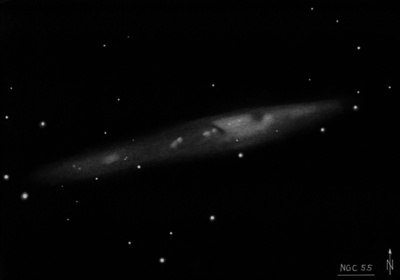
15x50 IS binoculars (10/21/06): although very low in the southern sky, visible as a faint, relatively large elongated patch using handheld IS binoculars. Easy to locate 3.8° NW of Alpha Phe as the galaxy is exactly collinear with three mag 7 stars to the east that are aligned east to west.
James Dunlop discovered NGC 55 = D 507 = h2315 on 7 Jul 1826 from Parramatta, New South Wales. Using his 9-inch f/12 speculum reflector, he described it as "a beautiful long nebula, about 25' in length; position N.p. and S.f., a little brighter towards the middle, but extremely faint and diluted to the extremities. I see several minute points or stars in it, as it were through the nebula: the nebulous matter of the south extremity is extremely rare, and of a delicate bluish hue. This is a beautiful object." Dunlop observed the galaxy on 4 nights and made a simple sketch (Figure 21).
John Herschel first observed this galaxy from the Cape on 3 May 1834: "bright; very large; very much elongated in a long irregular train, the preceding end being much the brightest. Whole length = 1.5 diam. of field, or 22' The nucleus is either a double star or a much more sharply terminated nebulous mass, elongated in a different position (146.5 ) from that of the nebula (109.8 )." He observed it again on 23 October 1835, recording it as "very bright; very large; very much elongated; at least 25' long and 3' broad. The following part is faint, the preceding and shorter trinuclear the 2d, nucleus taken. A strange object." His final observation on 4 October 1836 reads: "very bright, very large; a very long irregular crooked ray with 3 nuclei, the second of which appears to consist of stars." His sketch of the galaxy (fig. 8, plate IV) clearly shows its convoluted form and three brighter sections. In his discussion, he grouped it together with the galaxy NGC 300 and the star cluster NGC 1950 as "nebulae of irregular forms having a tendency to several centres of condensation; in the case of NGC 1950] but little conspicuous - in that of [NGC 55] (otherwise remarkable for its extravagant length and crooked shape) much more so, while in NGC 300], the formation of separate nuclei is decided, the intermediate faint nebula barely sufficing to mark them as forming a connected system."
Joseph Turner sketched NGC 55 using the 48" Great Melbourne Telescope on 29 Oct 1875 (plate I, figure 2 in "Observations of the Southern Nebulae made with the Great Melbourne Telescope from 1869 to 1885"). He reported "The present appearance agrees well with H.'s description and drawing. The 'following' portion is now much fainter than shown by H.'s sketch; indeed it is so very faint that its exact outlines cannot with certainty be determined, a faint whitishness being all that can be made out, while the star-like appearance described by H. in his portion cannot now be seen. The 'preceding' portion is still, as shown by H., much the brightest. There are still three nuclei, the centre one of which is much the brightest. H. says this one appears to consist of stars; but although I have tried several powers, I cannot with any certainty, determine this point, although it has, at times, a sparkling appearance. The 'following' portion of this nebula appears to have become much fainter since H. observed it." Turner's sketch shows the bright knot on the eastern end of the galaxy.
Sw. XI-2 (later IC 1537), found by Swift on 23 Sep 1897 and described as "eeeF; vL; eE; close f NGC 55; f of 2." is actually the ESE arm of NGC 55, which was sketched by both Dunlop and John Herschel (plate IV, #8).
200/250mm - 8" (9/25/81): very large, very elongated, brighter to the west, very faint eastern section.
300/350mm - 13.1" (11/5/83): fairly bright. The very faint eastern portion is near detached from the bright WNW section.
400/500mm - 17.5" (11/1/86): very large, edge-on 6:1 WNW-ESE, 16'x3'. Very asymmetric with a bright, elongated western portion, darker center and a faint eastern section (IC 1537). Faint stars are involved at the west side. The eastern portion appears tilted at a slight angle to the main western portion.
600/800mm - 30" (11/4/10 - Coonabarabran): NGC 55 nearly filled the 37' field of the 21mm Ethos at 264x, extending close to 30' in length WNW-ESE and roughly 4' in width. The structure was fascinating at 429x with a highly irregular surface brightness due to dusty patches and rifts, along with bright clumps and knots. The "bright" central section, which is offset WNW of center, spans ~9' in length. At the west end of the central section, the surface brightness dims significantly and the galaxy tapers, extending several arc minutes further WNW. At the ESE side of the central portion is a bright, elongated, mottled core, roughly 1' in length and slightly bulging. Just ESE of the core are two noticeable knots; the first is small but elongated, the second knot is very bright and elongated. With careful viewing the second knot resolved into two individual pieces or clumps. Continuing further ESE, the surface brightness drops significantly very quickly and a large, elongated dark notch appears to take a bite out of the galaxy. Just as the galaxy begins to brighten again towards the ESE end, there is another bright round knot and a second very small piece just detached to the ENE. At the ESE tip the galaxy brightens a bit more and has an irregular, patchy appearance with a couple of brighter stars superimposed.
Notes by Steve Gottlieb
NGC 288
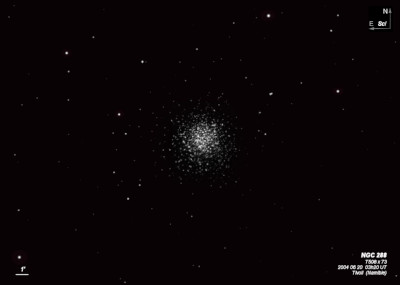
15x50 (8/25/06): easily visible in IS binoculars as a fairly large, diffuse glow.
William Herschel discovered NGC 288 = H VI-20 = h74 = h2354 on 27 Oct 1785 (sweep 467) and recorded "pB, L, oval round, bM, 7 or 8' long, 4 or 5' br." His summary description (including a 2nd observation) reads "cB, iR, 8 or 9' diameter, a great many of the stars visible, so that there can remain no doubt but that it is a cluster of vS stars." Caroline Herschel missed this cluster two years earlier when she discovered NGC 253. JH observed this globular both at Slough and at the Cape, where he recorded "globular cluster; bright; large; round; gradually brighter in the middle; all resolved into stars 12..16 mag; 5' diameter."
200/250mm - 8" (10/13/81): faint stars resolved across entire disc at 200x with averted, many near visual limit
8" (10/4/80): very large, grainy, few stars resolved at the NW and south edges, other clumps on the verge of resolution.
300/350mm - 13.1" (11/5/83): 30-40 stars resolved over haze.
400/500mm - 17.5" (8/29/92): very bright, very large, round, ~8' diameter. Well-resolved over entire disc into 75-100 stars mag 13-15 at White Mountains over background glow although not densely packed. 60 stars were resolved in a previous observation, only weakly concentrated in core.
600/800mm - 30" (10/15/15 - OzSky): this very loose globular appeared fully resolved at 303x. There were too many stars to possibly count, but certainly several hundred were resolved including a number of relatively bright stars (brightest members mag 12.6). The core was loosely overlaid with a dozen or so brighter stars. A number of stars in the halo appeared to be arranged in strings and arcs including one string extending towards the west.
Notes by Steve Gottlieb
NGC 300
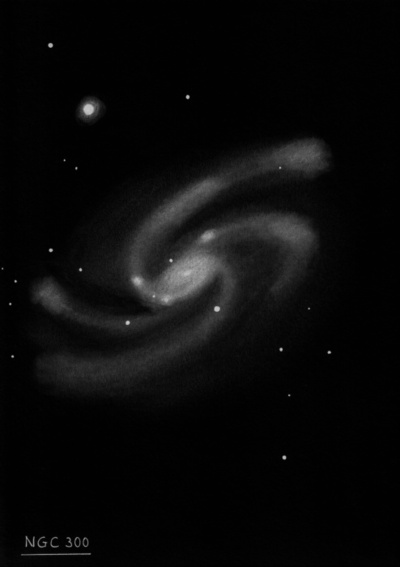
15x50 IS binoculars: (11/18/06): visible in binoculars as a relatively large, very low surface brightness hazy region, roughly 15' in size. A star is superimposed on the SW side.
James Dunlop discovered NGC 300 = D 530 = h2359 on 5 Aug 1826 with his 9" reflector and described "a pretty large faint nebula, irregular round figure, 6' or 7' diameter, easily resolvable into exceedingly minute stars, with four or five stars of more considerable magnitude; slight compression of stars to the centre." There are several superimposed Milky Way stars, although the resolution towards the center was spurious, of course. His position was 8' too far east.
John Herschel observed the galaxy on 3 occasions. On the first sweep (1 Sep 1834) he described it as "B; vL; vgpmbM; vmE; irregular figure; 8' to 10' long, 3' or 4' broad; has subordinate nuclei." His sketch (plate V, figure 10) includes the nucleus and two or three additional regions of nebulosity. Three nights later, he noted it as "faint, very large, very gradually brighter towards the middle; 4' long; 2' broad; has another nebula attached." The secondary nebula is the large HII complex [DCL88] 137 on the east side. On 30 Nov 1837 he wrote: "A large oval nebula, containing three stars." He had tentatively identified it with Dunlop 530, but noted: "Mr. Dunlop's neb 530 is described by him as easily resolvable into very minute stars. Its identity with [NGC 300] is therefore very doubtful."
Joseph Turner sketched NGC 300 with the 48" Great Melbourne Telescope on 20 Dec 1875 (plate I, figure 3). The giant HII complex on the east side is clearly shown on the sketch as a distinct oval patch. Pietro Baracchi showed it on his sketch from 7 Oct 1884 as a relatively large patch making a nearly equilateral triangle with two superimposed stars to the south. The galaxy was photographed by Harold Knox-Shaw at the Helwan Observatory between 1909-11 and described as a "spiral with many conensations".
300/350mm - 13.1" (9/22/84): fairly large oval 3:2 WNW-ESE, very diffuse appearance, bright stellar nucleus. There is a hint of structure although the galaxy has a low surface brightness and was viewed at a low elevation (13° at most) from my latitude of +38.5°. This nearby galaxy is located at a distance of 6 million light years in the Sculptor group, and may be physically paired with NGC 55.
600/800mm - 25" (10/21/17 - OzSky): at 187x; bright, extremely large, irregular, elongated roughly 5:3 WNW-ESE, at least 15'x9'. Contains a large, brighter core region with a mag 11.5 star at the ENE edge of the core. A mag 9.6 star is in the halo (along a faint spiral arm), 2.6' SW of center and a mag 10.6 star is superimposed in the outer halo, 5.3' SE of center. Spiral structure was surprisingly subtle. A low contrast, broad inner arm extends west from the north side of the core, curls south on the west side and spreads out. A more obvious inner arm emerges from the south side of the core and sweeps east and north, though the root of the arm is not defined. The arm passes through a relatively bright and large HII patch/OB association, ~25" diameter, situated 3.9' E of center and loses contrast further north. This giant HII complex is catalogued in NED as NGC 300:[DCL88] 137 from a 1988 study by Deharveng et al, "H II regions in NGC 300". A mag 11.5 star is 2.3' further NE in the outer halo of the galaxy. I didn't have time to examine the galaxy at higher power to search for additional H II knots.
Notes by Steve Gottlieb
NGC 7793
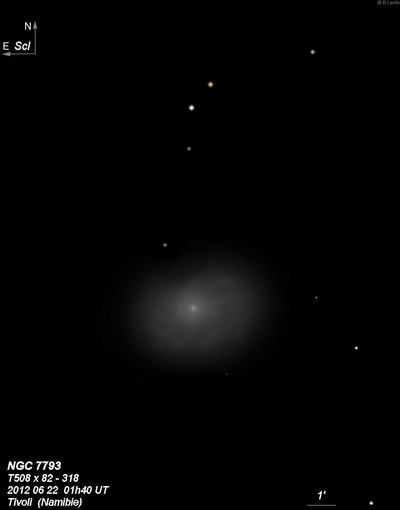
16x80mm (8/20/88): easily visible in the finder.
James Dunlop discovered NGC 7793 = D 608 = HN 4 on 14 Jul 1826 and recorded a "faint round nebula, about 2' diameter, with a very slight condensation towards the centre; a double star is north preceding" (2 observations). His position is 14' too far east (typical error). Apparently John Herschel didn't observe this galaxy from South Africa.
George Bond independently found the galaxy on 7 Nov 1850 at Harvard College Observatory with a 4" comet-seeker and announced it as a new discovery. Bond is credited with the discovery in the NGC. His RA is 40 seconds too large though he mentioned his position required further confirmation. Since John Herschel didn't include NGC 7793 in the GC (possibly because of Bond's comment) but Dreyer added it to the GC Supplement (6233). An accurate position from the Cordoba D.M was stated in the IC 1 notes.
Based on a photograph taken with the 30" Reynolds reflector at the Helwan Observatory between 1912-14, Harold Knox-Shaw first identified this galaxy as an "open spiral, knotty and complex." A later plate revealed a "bright sharp stellar nucleus" and "very many knots and patches."
200/250mm - 8" (11/8/80): very large, oval, low surface brightness.
400/500mm - 17.5" (8/20/88): bright, very large, oval 3:2 WSW-ENE, very large broadly brighter halo, small bright core. A mag 12 star is off the north side 2.8' from center.
600/800mm - 30" (10/15/15 - OzSky): at 303x; most of the detail seen in the 48" was visible, but the HII regions were not as obvious. The galaxy extended roughly 8' x 5' WNW-ESE and contained a relatively large core region that gradually brightened towards the center. Although the halo appeared mottled and ragged, spiral structure was subtle. A very low contrast "arm" extends due west on the northwest side of the core and another "arm" appeared to extend east on the southeast side of the core. I noted 4 HII regions: the most obvious is [H69] 20, a faint, 10" knot near the south edge of the halo, ~1.5' from center. [H69] 3/5, a larger, very diffuse isolated patch, perhaps 20" in size, was seen on the northeast edge of the halo, 2.9' from center. Closer to the core I noted two very low contrast knots, both ~8" in diameter. [H69] 11 is 1.3' NE of center and [H69] 10 is 1.2' E of center.
900/1200mm - 48" (10/31/13): bright showpiece galaxy, very large, oval 3:2 E-W, ~7'x4.5', large bright core. Spiral structure was evident, though it was difficult to trace individual arms except for one better defined arm attached on the west side of the core. This arm sweeps towards the east on the south side of the core (~2' from center) and ends just east of center. The halo appeared lumpy with an irregular surface brightness and several HII knots/associations were visible. The brightest individual knot is [H69] #20 from Paul Hodge's 1969 paper "HII Regions in 20 Nearby Galaxies". This fairly faint, 10" knot was easily seen 1.5' S of center, near the south side of the halo. [H69] #27, a slightly smaller and fainter patch is near the west-northwest end of the halo (1.9' from center). On the west-southwest side of the halo were two additional close, faint knots, both ~8" in diameter; [H69] #32 situated 2.3' from center and [H69] #33 at 2.4' from center. Finally, [H69] #3/5 is a fairly faint, 15" patch near the northeast edge of the halo, 2.8' from center. A mag 12.5 star is just off the northern edge, 2.9' from center.
Notes by Steve Gottlieb
NGC 613
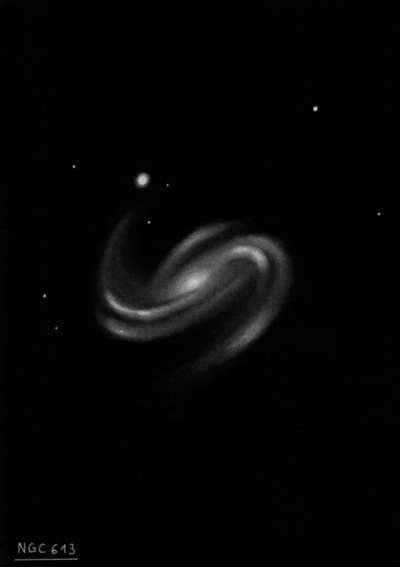
William Herschel discovered NGC 613 = H I-281 = h139 = h2422 on 9 Dec 1798 (sweep 1084) and recorded "cB, E np-sf, 5 or 6' long, 1 1/2' broad, a nucleus in the middle, A pretty considerable star is about 3' north of it, and a little following." James Dunlop independently found the galaxy on 5 Aug 1826 with his 9-inch f/12 speculum reflector and recorded "a very small round nebula, about 15" diameter, pretty well defined, bright at the center." Stephen O'Meara notes it is curious that Dunlop failed to note any elongation and didn't mention its proximity to the 10th magnitude star just off its NE flank.
John Herschel observed the galaxy both at Slough and at the Cape of Good Hope. On 27 Sep 1834, his Cape observation reads "vB; vL; vmE; pos 118.3 ; 1st gradually then suddenly much brighter to the middle to a nucleus 4' long 1.5' broad, has a star 9th mag N.f." He also noted that the position assigned in his Slough Catalogue was incorrect. On a second sweep, he logged "pB; vmE; pslbM, 2 1/2' length. No other near it within 3 fields in RA and 1 field's breadth in declination." Finally on a third sweep he logged "vB; L; vmE; pspmbM; has a *10; N.F."
200/250mm - 8" (11/28/81): faint, moderately large, diffuse, small bright core. A mag 9 star lies 2.5' NE.
400/500mm - 17.5" (12/4/93): fairly bright, very elongated 3:1 WNW-ESE, 4.0'x1.3', prominent elongated core, almost stellar nucleus with direct vision. The halo is broader with averted vision. There appeared to be a very faint extension or large knot southeast of the core . The DSS reveals this feature to be the bright spiral arm extending southeast from the central bar. Located 2.4' SW of mag 9 SAO 167149.
600/800mm - 30" (10/15/15 - OzSky): this very large barred spiral was a stunning showpiece at 303x! The bright central bar region is oriented NW-SE and extends ~2.5'x1' with the halo and arms stretching ~5'x3.6'. The central region was sharply concentrated with a very intense oval core that increased to a bright stellar nucleus. A prominent spiral arm was easily visible on the southeast end. It had a well defined edge and a high contrast as it emerged from the central region and unfurled east and north. The arm then dimmed significantly but could be followed as it bent backwards on the east side towards the northwest! The arm faded away before reaching a mag 9.6 star (SAO 167149) 2.2' NE of center. A second relatively bright, well-defined arm is attached on the northwest end of the bar and it curled south on the west end of the halo.
Notes by Steve Gottlieb
NGC 134
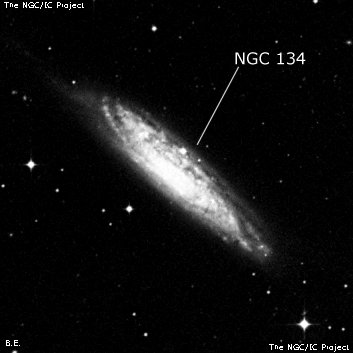
James Dunlop discovered NGC 134 = D 599 = D 590 with his 9" reflector on 7 Jul 1826. His description for D 599 reads "very faint nebula, about 25" diameter, rather elliptical. North of Eta Caelae Sculptoris. There are four small stars south of the nebula in the form of a lozenge." His position is 22' NNW of the galaxy but the description of the four nearby stars to the south clinches the identification. For D 590 he simply logged "a faint round nebula, about 2' diameter."
John Herschel's position is accurate and he noted that his h2327 could be identical D 590. He recorded it on 25 Sep 1834 as "vB; vL; vmE; pslbM; 8' long; 1' broad; pos = 47.9°; dies away gradually at both extremities; has a star 10th mag., distance 45", pos = 327.9. On a second sweep on 19 Oct 1835 he logged "bright; large; vmE; pretty suddenly little brighter middle; 4' long; 1' broad; position = 227°; the following of 2." He also sketched the galaxy (Plate VI, figure 19), clearly showing its spindle-shape with tapering edges.
Joseph Turner sketched NGC 134 on 2 Nov 1875 with the 48" Melbourne Telescope and noted, "The present appearance of nebula is exactly as represented in Herschel's sketch; the centre is sharp and stellar-like with power of 255; but with 420 it is more diffused, and somewhat sparkling. A careful examination leaves the impression that it is practically unchanged since Herschel's time, the only difference between his sketch and present aspect being the position of the North star, which in Herschel's sketch is shown in a straight line with the centre of nebula and s.f. star, whilst at present it is somewhat to the n.f. of that point; this may however be the fault of the engraver."
200/250mm - 8" (11/8/80): fairly faint, elongated, low surface brightness.
300/350mm - 13.1" (9/22/84): fairly bright, very elongated SW-NE, small bright core, sharp edge along the west side. A star is off the preceding side.
400/500mm - 17.5" (12/3/88): bright, fairly large, very elongated SW-NE, sharp concentration with a bright core and long faint arms. Two mag 13.5 stars are nearby; one at the preceding edge 40" NW of center and one on the opposite side of the core, 1.5' SE of center. NGC 131 is in the field 9' WSW.
Notes by Steve Gottlieb
NGC 289
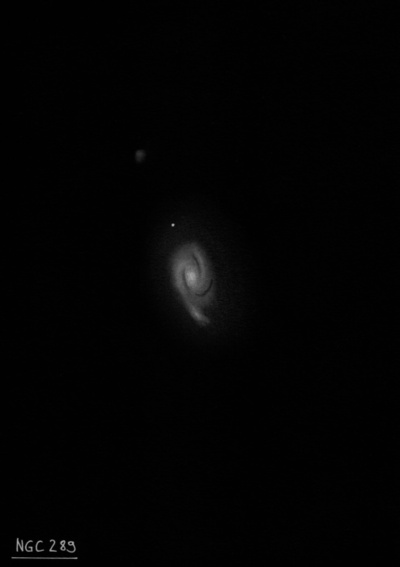
John Herschel discovered NGC 289 = h2355 on 27 Sep 1834 and logged "vB; L; pmE; oval; has a star 11th mag north preceding.". His position and description is accurate.
In 1914, Hardcastle classified NGC 246 as a "spindle-shaped nebula" but the following year, Knox-Shaw reported it was a"open spiral" based on a photograph taken at the Helwan Observatory with the Reynolds reflector.
300/350mm - 13.1" (9/22/84): fairly bright, oval ~E-W. A mag 13 star is off the west edge.
400/500mm - 17.5" (12/3/88): fairly bright, fairly large, oval NW-SE, broad concentration. A mag 13.5 star is off the NW edge 3.2' from the center. Brightest in a group that includes NGC 254 situated 1.1° WSW.
Notes by Steve Gottlieb
NGC 7713
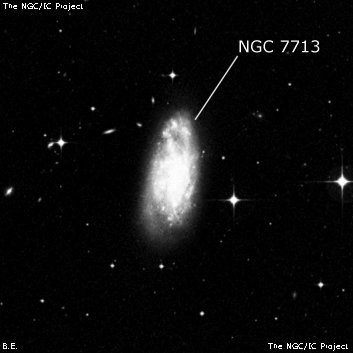
John Herschel discovered NGC 7713 = h4000 on 4 Oct 1836 and recorded "pB; oval; or pmE; vgbM; 3'." The NGC has 30' error in north polar distance due to a misprint in GC, but JH's original NPD is accurate. Innes noted the error in Monthly Notices 58,330 and Dreyer included the correction in the IC 2 Notes.
200/250mm - 8" (8/16/82): very faint, elongated NNW-SSE, weak concentration. Located 40' ESE of Beta Sculptoris (V = 4.4).
400/500mm - 17.5" (10/20/90): fairly faint, moderately large, elongated 5:2 NNW-SSE, broad concentration. A mag 13 star is at the north tip. Located just east of two mag 10 and 11 stars; the closer mag 11 star is 2' W of center. NGC 7713A lies 17' NE (not seen).
600/800mm - 24" (9/26/19): at 200x and 375x: fairly bright, large, very elongated 3:1 ~N-S, ~3.5'x1.2', broad concentration and slightly brighter center in a N-S orientation but no distinct nucleus. The surface brightness appeared irregular but this galaxy is too far south to resolve any knots or other detail. A mag 11.3 star is 1.8' SW of center with a mag 10.1 star 4.8' W. A mag 13.3 star is off the N end [3.3' from center] and a mag 15 star is off the S end [2.6' from center].
NGC 7713A, located 17' NNE, appeared fairly faint, round, 1' diameter, low even surface brightness. The galaxy is collinear with a mag 12.3 star 2.6' NE and a mag 9.2 star (HD 222071) 6.4' NE.
Notes by Steve Gottlieb
NGC 439
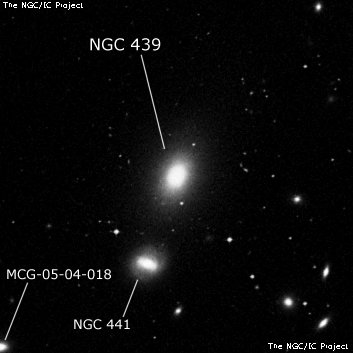
John Herschel discovered NGC 439 = h2394 (along with NGC 441 = h2395) on 27 Sep 1834 and logged "pB, R, bM, 20 arcseconds." His mean position from 2 sweeps is accurate.
200/250mm - 8" (1/1/84): very faint, small, round. Can just hold steadily with averted vision. A mag 8 star is 10' SW.
400/500mm - 17.5" (11/6/93): fairly faint, moderately large, elongated 4:3 NNW-SSE, 1.5'x1.2', broad concentration. A mag 13.5 star is 2.3' SW and a mag 14 star is 2.2' SE of center. Brighter of a pair with NGC 441 2.5' SSE. Located 11' NE of mag 8.2 SAO 192988. This is the brightest member of ACO S141.
600/800mm - 24" (9/15/12): at 175x appeared fairly bright, moderately large, oval 4:3 NNW-SSE, 1.5'x1.2', increases to a bright core.
NGC 439 is the brightest in the cluster ACO S141 = Klemola 1 with NGC 441 2.6' SSE, MCG -05-04-018 7' SE and a trio of MCGs (-011/-012/-013) 5' SW. MCG -05-04-018 appeared fairly faint, fairly small, oval 3:2 E-W, 24"x16" and the small trio of MCGs were all between extremely faint and very faint, round, 12" to 18" diameter.
Notes by Steve Gottlieb
NGC 24
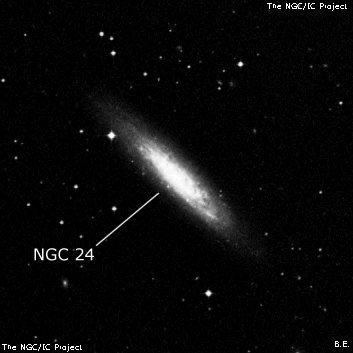
William Herschel discovered NGC 24 = H III-461 = h2308 on 27 Oct 1785 (sweep 467) and logged it as "vF, cL, lE, glbM, 4 or 5' long." John Herschel logged it from the Cape as "F; vL; vmE; vgbM; 4' l; 1' br." Pietro Baracchi, observing with the 48" Melbourne telescope on 9 Dec 1887, called it "pF; L; vmE; gbM; fades away gradually at the ends - outline not well defined, woolly." Herbert Howe, using the 20" refractor at Chamberlin Observatory, reported the length as 3' and PA = 45°.
400/500mm - 17.5" (8/2/86): moderately bright, pretty edge-on 5:1 SW-NE, 4.0'x0.8', large bright core. A mag 12 star is just east of the NE end. This is a little-known striking spiral.
Notes by Steve Gottlieb
NGC 7507
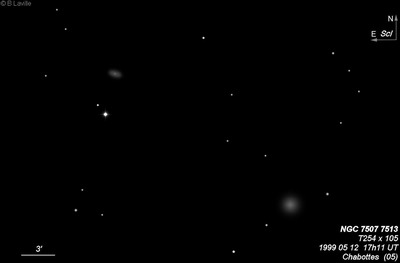
William Herschel discovered NGC 7507 = H II-2 = h2211 = h3974 on 30 Oct 1783 (#2 sweep discovery). He made a total of 3 observations and noted on 1 Sep 1785 (sweep 430), "pB, S, irr figure, mbM." JH made observations both at Slough and at the CGH, where he logged "B; R; psvmbM; 60"."
200/250mm - 8" (7/24/82) : fairly bright, small, small very bright core.
400/500mm - 17.5" (10/13/90): bright, fairly small, round, unusually bright compact core, stellar nucleus. Located 6' NW of a mag 10 star. NGC 7513 lies 18' NE.
Notes by Steve Gottlieb
NGC 150
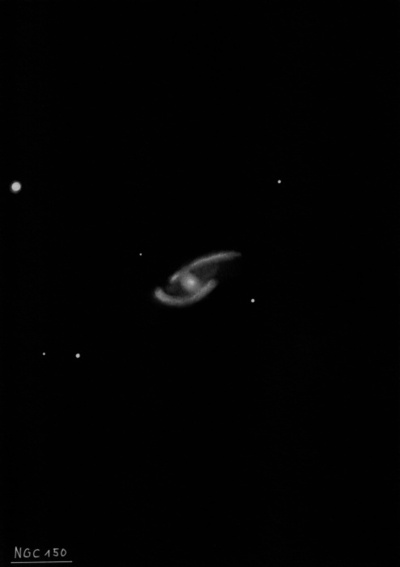
Lewis Swift discovered NGC 150 = Sw. VI-3 on 20 Nov 1886 with his 16" refractor. His position was 30 seconds of RA west of ESO 410-019 = PGC 2052. Herbert Howe measured an accurate position in 1899-00 using the 20" refractor at Chamberlin Observatory (repeated in the IC 2 notes). The error was also noted in the Harvard College Observatory NGC correction list. The galaxy was photographed by Harold Knox-Shaw at the Helwan Observatory between 1909-11 and described as a "two-branched spiral".
300/350mm - 13.1" (10/20/84): moderately bright, moderately large, elongated 2:1 WNW-ESE, weak concentration, irregular surface brightness [probably due to spiral arms], slightly mottled.
Notes by Steve Gottlieb
NGC 131
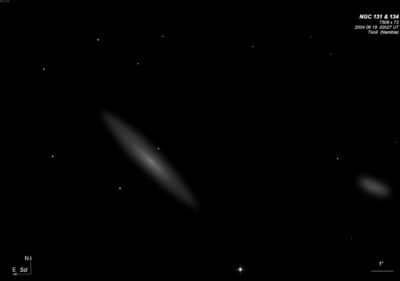
John Herschel discovered NGC 131 = h2326 on 25 Sep 1834 and logged "pretty bright; pretty large; pretty much elongated; very gradually brighter in the middle." On a later sweep he noted "very faint; the preceding of two. The other [NGC 134] very large and bright."
400/500mm - 17.5" (12/3/88): very faint, very small, oval WSW-ENE, weak concentration. A mag 14.5 star is off the ENE edge. Located 9' WSW of much brighter NGC 134.
Notes by Steve Gottlieb
NGC 544
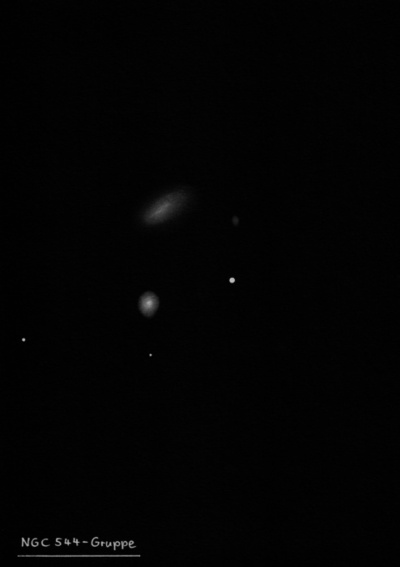
John Herschel discovered NGC 544 = h2411 (along with nearby NGC 534 = h2410 and NGC 546 = h2412) on 23 Oct 1835. His description reads "eeF; the Sp of two [with NGC 546] which form an equilateral triangle with a star 13th mag" and matches ESO 296-024 = PGC 5253.
400/500mm - 17.5" (11/1/97): very faint, very small, round, 25" round, weak concentration to a slightly brighter core. Precedes a mag 14 star by 1.5' and forms a close pair with NGC 546 1.5' N; the two galaxies and the star form a nearly perfect equilateral triangle. Located ~15' SW of the core of the distant AGC 2911.
Notes by Steve Gottlieb
NGC 526
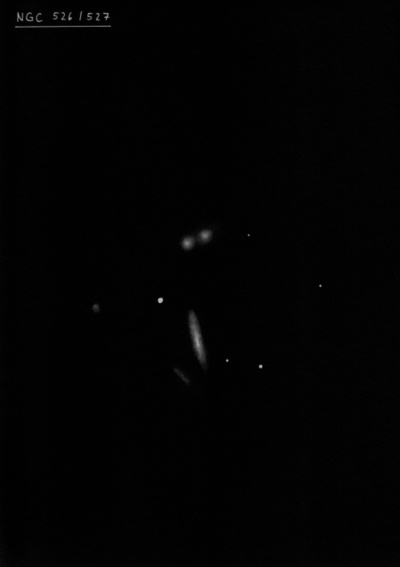
John Herschel discovered NGC 526 = h2408 (along with NGC 527 = h2409) on 1 Sep 1834 and recorded "pB, S, rather a doubtful object. The preceding of two [with NGC 527]". On a later sweep he noted "vF;; S; lE; this is the "doubtful" neb of a former sweep." This double system consists of NGC 526A = PGC 5120 and NGC 526B = PGC 5135.
400/500mm - 17.5" (11/1/97): initially NGC 526 appeared as a very faint, small glow, slightly elongated WNW-ESE. After extended viewing, it resolved at times into a close double system with NGC 526B = MCG -06-04-020 = PGC 5135, [35" between centers] that was oriented WNW-ESE. Both galaxies had very small brighter cores at moments. Forms a trio with NGC 527 3.1' S.
Notes by Steve Gottlieb
